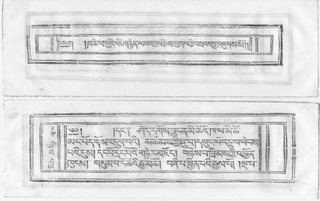Bsdus yig 1
I have recently added to "Nyer mkho" (to your left) two links which take you to the scanned editions of the Journal Asiatique and the BEFEO available so far. I have not had the chance to browse through all of them, but one article which I found very useful is Jacques Bacot's L'écriture cursive tibétaine, the first article in JA XIX. 1912 Jan-Feb. If you are working with dbu med manuscripts this will be invaluably helpful as it can be taken for granted that sooner or later you will bump into a strange contraction (bsdus yig). Bacot lists and solves 710 of these (including about 200 of Csoma's). A short introductory note explains some of the (not so constant) underlying principles of how contractions are made and some instances where readings can be misinterpreted at first glance. Many more could be added, such as the witty 4n for bzhin (4=bzhi), etc.
Note that many errors in blockprints come about with the copyist or carver misreading the dbu med script in front of him. I came across one such amusing example in Shar rdza Bkra shis rgyal mtshan's Legs bshad rin po che'i gter mdzod (the Chinese edition). When listing the northern countries among the Hor, he mentions "spu gur" (="fur-tent"), which might have seemed plausible for some readers recalling nomadic tents. He surely meant yu gur, that is the Uygurs, but sp- and y- are very similar and "fur-tents" rhymed nicely with the context. I wonder how many "fur-tents" did Csoma skip when scanning Tibetan texts for the Uygurs.
Note that many errors in blockprints come about with the copyist or carver misreading the dbu med script in front of him. I came across one such amusing example in Shar rdza Bkra shis rgyal mtshan's Legs bshad rin po che'i gter mdzod (the Chinese edition). When listing the northern countries among the Hor, he mentions "spu gur" (="fur-tent"), which might have seemed plausible for some readers recalling nomadic tents. He surely meant yu gur, that is the Uygurs, but sp- and y- are very similar and "fur-tents" rhymed nicely with the context. I wonder how many "fur-tents" did Csoma skip when scanning Tibetan texts for the Uygurs.






